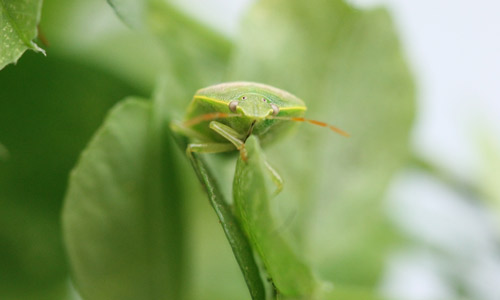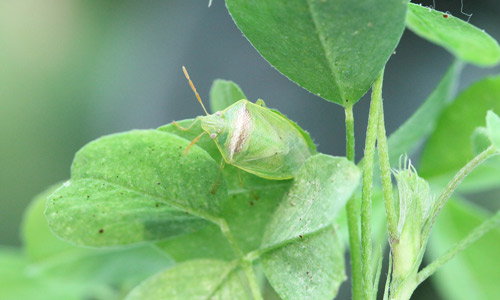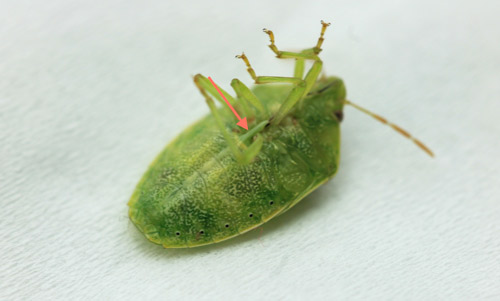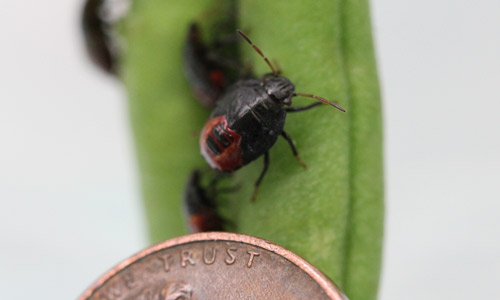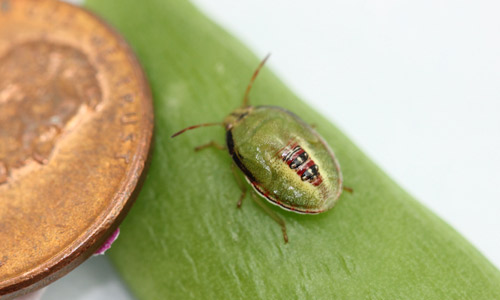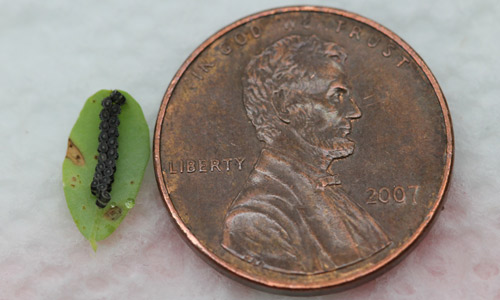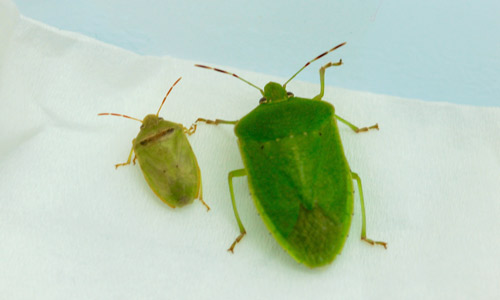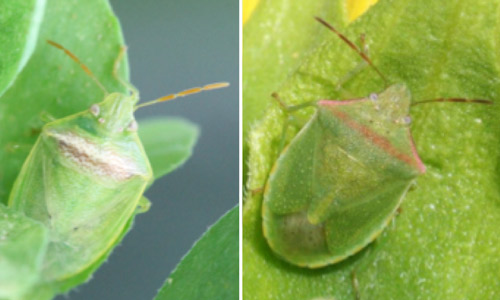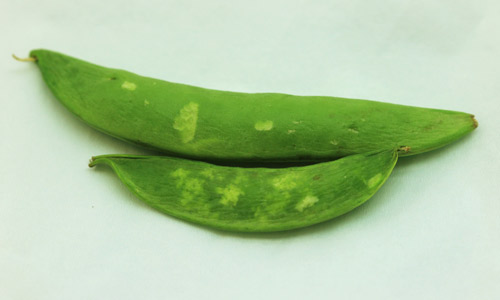common names: redbanded stink bug, red-banded stink bug, smaller green stink bug (suggested common names)
scientific name: Piezodorus guildinii (Westwood) (Insecta: Hemiptera: Pentatomidae)
Introduction - Distribution - Description - Life Cycle - Similar Species - Host Plants - Damage - Management - Selected References
Introduction (Back to Top)
The redbanded stink bug, Piezodorus guildinii, is a Neotropical stink bug that has recently become established in the southeastern United States (Figure 1). The redbanded stink bug feeds on many leguminous plants including several economically important crops such as beans, peas, alfalfa, and lentils. In South America, the redbanded stink bug has become one of the most significant pests of soybean, Glycine max (Smaniotto and Panizzi 2015).
Figure 1. Anterior view of adult redbanded stink bug, Piezodorus guildinii (Westwood), on alfalfa, Medicago sativa. Photograph by Morgan Pinkerton, University of Florida, Entomology and Nematology Department.
Figure 2: Dorsal view of an adult redbanded stink bug, Piezodorus guildinii (Westwood), on alfalfa, Medicago sativa. Photograph by Morgan Pinkerton, University of Florida, Entomology and Nematology Department.
Distribution (Back to Top)
The first description of the redbanded stink bug originated from the Caribbean island of St. Vincent. This pest is present in both Central and South America and has caused major economic damage throughout South America. In Brazil, Uruguay and Argentina, the redbanded stink bug is one of the most prevalent pests of soybean (Akin et al. 2011). The redbanded stink bug was first reported in the United States in the early 1970s but the time of its arrival in North America is still unclear (Panizzi 2005). It is currently found from Argentina to the southern United States and it was not until 2002 that the redbanded stink bug was considered a major economic pest in the U.S. (Husseneder et al. 2016). As of 2016, the redbanded stink bug has been recorded in several southern states including Alabama, Florida, Georgia, Louisiana, Mississippi, New Mexico, South Carolina, and Texas (Temple et al. 2013).
Description (Back to Top)
Adults: Adults are small, glossy, green stink bugs, and are on average 8-11mm in length and 4-6mm in width across the pronotum (Zerbino et al. 2014). The adult usually has a single band across the pronotum that is cream colored or red but periodically appear orange to deep purple (Figure 2). This is natural variation within the species. In many cases, the connexivum, or the outer dorsal edge of the flattened part of the abdomen, also shows the same colorations as the pronotal band. A key feature to the identification of adult redbanded stink bugs is the presence of a long spine on the ventral side of the abdomen (Figure 3).
Figure 3. Ventral view of the spine on the abdomen of the redbanded stink bug, Piezodorus guildinii (Westwood). Photograph by Morgan Pinkerton, University of Florida, Entomology and Nematology Department.
Figure 4. Redbanded stink bug, Piezodorus guildinii (Westwood), adult with the horizontal red band. Photograph by Morgan Pinkerton, University of Florida, Entomology and Nematology Department.
Nymphs: Nymphs undergo five instars before becoming adults. Each instar lasts 3-13 days with the 3rd instar being the longest (Panizzi and Smith 1977). In laboratory colonies, nymphs can reach adulthood in as little as 20 days (Zerbino et al. 2013). Nymphal development and survival is optimal at temperatures around 27°C (Gomez et al. 2013). Nymphs can survive in a relative humidity range from 50% to 90% (Zerbino et al. 2013). Similar to other stink bugs, the first instars do not feed (Silva et al. 2013). In early instars, the pronotum and head are often black while the abdomen is red with black markings (Figure 5). Later instars develop a green coloration with black markings and a few thick, red and black stripes dorsally on the abdomen (Figures 5-8).
Figure 5. Redbanded stink bug, Piezodorus guildinii (Westwood), first instars. Photograph by Morgan Pinkerton, University of Florida, Entomology and Nematology Department.
Figure 6. Redbanded stink bug, Piezodorus guildinii (Westwood), second instars. Photograph by Morgan Pinkerton, University of Florida, Entomology and Nematology Department.
Figure 7. Redbanded stink bug, Piezodorus guildinii (Westwood), third instars. Photograph by Morgan Pinkerton, University of Florida, Entomology and Nematology Department.
Figure 8. Redbanded stink bug, Piezodorus guildinii (Westwood), fourth instar. Photograph by Morgan Pinkerton, University of Florida, Entomology and Nematology Department.
Figure 9. Redbanded stink bug, Piezodorus guildinii (Westwood), fifth instar. Photograph by Morgan Pinkerton, University of Florida, Entomology and Nematology Department.
Eggs: Overwintering adults lay eggs in spring to begin the first generation of the year. Generally, the 4-8 annual generations begin to overlap in July (Panizzi and Smith 1977). Oviposition begins about 16 days following the imaginal molt and subsequent mating (Panizzi and Smith 1977). Eggs are black in color and cylindrical (Figure 10). Clutches are laid as two side by side rows, varying in numbers of eggs but generally containing 13-17 eggs per clutch. Oviposition preferentially occurs directly on bean pods; however, eggs can also be found on the undersides of leaves, stems, and other parts of the plant. The eggs take about 7.5 days to hatch under optimal conditions (Panizzi and Smith 1977).
Figure 10. Redbanded stink bug, Piezodorus guildinii (Westwood), eggs. Photograph by Morgan Pinkerton, University of Florida, Entomology and Nematology Department.
Life Cycle (Back to Top)
The redbanded stink bug takes 37-39 days to undergo a complete lifecycle under ideal conditions. In Louisiana, it is estimated that between four and eight generations can occur per year (Akin et al. 2011). Adults appear to undergo reproductive diapause in the winter, which extends the lifespan of the overwintering generation (Zerbino et al. 2014). However, overall mortality appears to be higher in short day winter photoperiods (Zerbino et al. 2013). Several generations (4-8) occur annually and can overlap beginning in July (Panizzi and Smith 1977).
Similar Species (Back to Top)
The redbanded stink bug is similar in appearance to other common stink bugs and can occasionally be found on the same plants. The Southern green stink bug, Nezara viridula (L.), and the green stink bug, Chinavia hilaris (Say), can be confused with adult Piezodorus guildinii due to coloration, but are easily distinguished because they are twice the size of Piezodorus. guildinii (Figure 11). Other possible adult look-alikes are bugs in the genus Thyanta. Thyanta custator (Fabricius), the red shouldered stink bug, is green with a similar red band on the pronotum. However, Thyanta spp. have a dull finish to the dorsal surface and do not have the distinct ventral spine as in the redbanded stink bug (Figure 12). Nymphs of Thyanta spp. appear similar to Piezodorus guildinii but they can be distinguished based on body shape and stripes. Thyanta spp. nymphs are more similar in shape to other stink bugs with the body width about equal to the length; whereas, redbanded nymphs are oval with the length greater. Furthermore, Thyanta spp. have many more thin horizontal stripes across the dorsal abdomen (Akin et al. 2011).
Figure 11. Redbanded stink bug, Piezodorus guildinii (Westwood), (left), next to the Southern green stink bug, Nezara viridula (L.) (right). Photograph by Morgan Pinkerton, University of Florida, Entomology and Nematology Department.
Figure 12. Redbanded stink bug, Piezodorus guildinii (Westwood), (left), and look-alike the redshouldered stink bug, Thyanta sp. (right). Photograph by Morgan Pinkerton, University of Florida, Entomology and Nematology Department (left), and Russ Ottens, University of Georgia, Bugwood.org (right).
Host Plants (Back to Top)
Like many other pest stink bugs, the redbanded stink bug is polyphagous but appears to have a narrower host range compared to other stink bugs. This pest primarily feeds on fabaceous plants including peas, beans, and other legumes. Several of these hosts are of economical importance with the most important being soybean. Other economically significant hosts include beans (Phaseolus vulgaris), peas (Pisum sativum), lentils (Lens culinaris), alfalfa (Medicago sativa), and other forage legumes (Zerbino et al. 2014). The redbanded stink bug also feeds on weedy legumes such as Crotalaria spp. and Indigofera spp. (Panizzi and Slansky Jr 1985).
Figure 13. Redbanded stink bug, Piezodorus guildinii (Westwood), nymphs feeding on green beans, Phaseolus vulgaris. Photograph by Morgan Pinkerton, University of Florida, Entomology and Nematology Department.
Damage (Back to Top)
A stink bug damages plants by piercing plant tissues with a long stylet. Damage can occur to leaves and stems but the majority of feeding is on the seedpods. Stink bugs inject salivary enzymes into the plants to break down tissues. In soybeans, this feeding behavior can reduce yields and delay maturation of the plants. Pods are marked and the internal soybeans can shrivel. The damage can also make plants susceptible to pathogens such as fungi. Due to their extended duration of feeding, the redbanded stink bug appears to cause a significantly higher level of seed damage than other Neotropical stink bugs (Depieri and Panizzi 2011).
Figure 14. Internal stink bug damage to soy bean, Glycine max. Photograph by Ric Bessin, University of Kentucky.
Figure 15. External stink bug damage to sweet pea, Pisum sativum. Photograph by Morgan Pinkerton, University of Florida, Entomology and Nematology Department.
Management (Back to Top)
Monitoring: One method of monitoring for the redbanded stink bug is visual sampling of fields on a weekly basis. Infestations can occur rapidly and large numbers can be hard to control. Monitoring consists of looking for eggs, nymphs and adults or any suspicious damage to plants, fruits or seeds.
Another method for monitoring for Piezodorus guildinii is to sample fields using a sweep net. It is recommended to use a 15-inch-diameter sweep net in the early morning or late evening. In Lousiana and Arkansas, the economic threshold for soybean is 6 bugs in 25 sweeps in soybean (Akin et al. 2011).
A trap with a lure has not yet been developed specifically for Piezodorus guildinii. However, Piezodorus guildinii responds well to the pheromone lure for Euschistus heros in the Neotropics (Borges et al. 1998). Euschistus heros is another Neotropical stink bug, but it has not established in the United States.
Cultural: Early maturing varieties of crops can be planted to avoid stink bugs since they typically are a late season pest. This cultural control practice is recommended for all stink bugs including the redbanded stink bug (Akin et al. 2011). Furthermore, it is suggested that Piezodorus guildinii can be managed using insect resistant varieties in soybean (Silva et al. 2013).
Chemical: Chemical control does not appear to be as effective for Piezodorus guildinii as for other common stink bugs. Insecticides with mixtures of active ingredients and rotation of insecticides is essential to avoid insecticidal resistance (Akin et al. 2011).
Selected References (Back to Top)
- Akin S, Phillips J, Johnson DT. 2011. Biology, identification and management of the redbanded stink bug. University of Arkansas Agricultural and Natural Resources Extension Document FSA7078. (2 July 2017)
- Borges M, Schmidt FGV, Sujii ER, Medeiros ME, Mori K, Zarbin PHG, Ferreira JTB. 1998. Field responses of stink bugs to the natural and synthetic pheromone of the neotropical brown stink bug, Euschistus heros (Heteroptera: Pentatomidae). Physiological Entomology 23: 202-207.
- Depieri R, Panizzi AR. 2011. Duration of feeding and superficial and in-depth damage to soybean seed by selected species of stink bugs (Heteroptera: Pentatomidae). Neotropical Entomology 40: 197-203.
- Gomez VEF, Gaona P, Arias OR, De Lopez MB, Ocampos O. 2013. Aspectos biológicos de Piezodorus guildinii (Westwood) (Hemiptera: Pentatomidae) criados con diferentes dietas en condiciones de laboratorio. Revista de la Sociedad Entomológica Argentina 72: 27-34.
- Husseneder C, Park JS, Howells A, Tikhe CV, Davis JA. 2017. Bacteria associated with Piezodorus guildinii (Hemiptera: Pentatomidae), with special reference to those transmitted by feeding. Environmental Entomology 46: 159-166.
- Panizzi AR. 2005. Small Green Stink Bug, Piezodorus guildinii (Westwood) (Hemiptera: Heteroptera: Pentatomidae), p. 2030. In Capinera JL (ed.), Encyclopedia of Entomology. DOI 10.1007/0-306-48380-7.
- Panizzi AR, Slansky Jr F. 1985. New host plant records for the stink bug Piezodorus guildinii in Florida (Hemiptera: Pentatomidae). Florida Entomologist 68: 215-216.
- Panizzi AR, Smith JG. 1977. Biology of Piezodorus guildinii: Oviposition, development time, adult sex ratio, and longevity. Annals of the Entomological Society of America 70: 35-39.
- Silva JPGF, Baldin ELL, Souza ES, Canassa VF, Lourenção AL. 2013. Characterization of antibiosis to the redbanded stink bug Piezodorus guildinii (Hemiptera: Pentatomidae) in soybean entries. Journal of Pest Science 86: 649-657.
- Smaniotto LF, Panizzi AR. 2015. Interactions of selected species of stink bugs (Hemiptera: Heteroptera: Pentatomidae) from leguminous crops with plants in the Neotropics. Florida Entomologist 98: 7-17.
- Temple AJH, Davis JA, Micinski S, Hardke JT, Price P. 2013. Species composition and seasonal abundance of stink bugs (Hemiptera: Pentatomidae) in Louisiana soybean. Community and Ecosystem Ecology 42: 648-657.
- Zerbino MS, Altier NA, Panizzi AR. 2013. Effect of photoperiod and temperature on nymphal development and adult reproduction of Piezodorus guildinii (Heteroptera: Pentatomidae). Florida Entomologist 96: 572-582.
- Zerbino MS, Altier NA, Panizzi AR. 2014. Seasonal occurrence of Piezodorus guildinii on different plants including morphological and physiological changes. Journal of Pest Science 88: 495-505.
